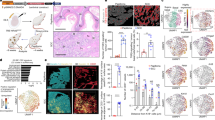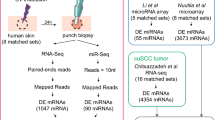Abstract
To study ROCK2 activation in carcinogenesis, mice expressing 4-hydroxytamoxifen (4HT)-activated ROCK2 (K14.ROCKer) were crossed with mice expressing epidermal-activated rasHa (HK1.ras1205). At 8 weeks, 4HT-treated K14.ROCKer/HK1.ras1205 cohorts exhibited papillomas similar to HK1.ras1205 controls; however, K14.ROCKer/HK1.ras1205 histotypes comprised a mixed papilloma/well-differentiated squamous cell carcinoma (wdSCC), exhibiting p53 loss, increased proliferation and novel NF-κB expression. By 12 weeks, K14.ROCKer/HK1.ras1205 wdSCCs exhibited increased NF-κB and novel tenascin C, indicative of elevated rigidity; yet despite continued ROCK2 activities/p-Mypt1 inactivation, progression to SCC required loss of compensatory p21 expression. K14.ROCKer/HK1.ras1205 papillomatogenesis also required a wound promotion stimulus, confirmed by breeding K14.ROCKer into promotion-insensitive HK1.ras1276 mice, suggesting a permissive K14.ROCKer/HK1.ras1205 papilloma context (wound-promoted/NF-κB+/p53−/p21+) preceded K14.ROCKer-mediated (p-Mypt1/tenascin C/rigidity) malignant conversion. Malignancy depended on ROCKer/p-Mypt1 expression, as cessation of 4HT treatment induced disorganized tissue architecture and p21-associated differentiation in wdSCCs; yet tenascin C retention in connective tissue extracellular matrix suggests the rigidity laid down for conversion persists. Novel papilloma outgrowths appeared expressing intense, basal layer p21 that confined endogenous ROCK2/p-Mypt1/NF-κB to supra-basal layers, and was paralleled by restored basal layer p53. In later SCCs, 4HT cessation became irrelevant as endogenous ROCK2 expression increased, driving progression via p21 loss, elevated NF-κB expression and tenascin C-associated rigidity, with p-Mypt1 inactivation/actinomyosin-mediated contractility to facilitate invasion. However, p21-associated inhibition of early-stage malignant progression and the intense expression in papilloma outgrowths, identifies a novel, significant antagonism between p21 and rasHa/ROCK2/NF-κB signalling in skin carcinogenesis. Collectively, these data show that ROCK2 activation induces malignancy in rasHa-initiated/promoted papillomas in the context of p53 loss and novel NF-κB expression, whereas increased tissue rigidity and cell motility/contractility help mediate tumour progression.







Similar content being viewed by others
References
Olson MF, Sahai E . The actin cytoskeleton in cancer cell motility. Clin Exp Metastasis 2009; 26: 273–287.
Dufort CC, Paszek MJ, Weaver VM . Balancing forces: architectural control of mechanotransduction. Nat Rev Mol Cell Biol 2011; 12: 308–319.
Rath N, Olson MF . Rho-associated kinase in tumorigenesis: re-considering ROCK inhibition for cancer therapy. EMBO Rep 2012; 13: 900–908.
Kumper S, Marshall CJ . ROCK-driven actomyosin contractility induces tissue stiffness and tumor growth. Cancer Cell 2011; 19: 695–697.
Samuel MS, Lopez JL, McGhee EJ, Croft DR, Strachan D, Timpson P et al. Actomyosin-mediated cellular tension drives increased tissue stiffness and β-Catenin activation to induce epidermal hyperplasia and tumor growth. Cancer Cell 2011; 19: 776–791.
Ibbetson SJ, Pyne NT, Pollard AN, Olson MF, Samuel MS . Mechanotransduction pathways promoting tumor progression are activated in invasive human squamous cell carcinoma. Am J Pathol 2013; 183: 930–937.
Kamai T, Tsujii T, Arai K, Takagi K, Asami H, Ito Y et al. Significant association of Rho/ROCK pathway with invasion and metastasis of bladder cancer. Clin Cancer Res 2003; 9: 2632–2641.
Sadok A, McCarthy A, Caldwell J, Collins I, Garrett MD, Yeo M et al. Rho kinase inhibitors block melanoma cell migration and inhibit metastasis. Cancer Res 2015; 75: 2272–2284.
Benitah SA, Valerón PF, Lacal JC . ROCK and nuclear factor-kappaB dependent activation of cyclooxygenase-2 by Rho GTPases: effects on tumor growth and therapeutic consequences. Mol Biol Cell 2003; 14: 3041–3054.
Perona R, Montaner S, Saniger L, Sanchez-Perez I, BravoR, Lacal JC . Activation of the nuclear factor-κB by Rho, CDC42, and Rac-1 proteins. Genes Dev 1997; 11: 463–475.
Olson MF, Paterson HF, Marshall CJ . Signals from Ras and Rho GTPases interact to regulate expression of p21Waf1/Cip1. Nature 1998; 394: 295–299.
Croft DR, Olson MF . The Rho GTPase effector ROCK regulates cyclin A, cyclin D1 and p27Kip1 levels by distinct mechanisms. Mol Cell Biol 2006; 26: 4612–4627.
Keely PJ . Mechanisms by which the extracellular matrix and integrin signalling act to regulate the switch between tumor suppression and tumor promotion. J Mammary Gland Biol Neoplasia 2011; 16: 205–219.
Castellano E, Downward J . RAS interaction with PI3K: more than just another effector pathway. Genes Cancer 2011; 2: 261–274.
Samuel MS, Munro J, Bryson S, Forrow S, Stevenson D, Olson MF . Tissue selective expression of conditionally-regulated ROCK by gene targeting to a defined locus. Genesis 2009; 47: 440–446.
Balmain A, Yuspa SH . Milestones in skin carcinogenesis: the biology of multistage carcinogenesis. J Invest Dermatol 2014; 134: 2–7.
Greenhalgh DA, Rothnagel JA, Wang XJ, Quintanilla MI, Orengo CC, Gagne TA et al. Induction of epidermal hyperplasia, hyperkeratosis, and papillomas in transgenic mice by a targeted v-Ha-ras oncogene. Mol Carcinog 1993a; 7: 99–110.
Greenhalgh DA, Quintanilla MI, Orengo CC, Barber JL, Eckhardt JN, Rothnagel JA et al. Cooperation between v-fos and v-rasHa induces autonomous papillomas in transgenic epidermis but not malignant conversion. Cancer Res 1993c; 53: 5071–5075.
Yao D, Alexander CL, Quinn JA, Porter MJ, Wu H, Greenhalgh DA . PTEN loss promotes rasHa-mediated papillomatogenesis via dual up-regulation of AKT activity and cell cycle deregulation but malignant conversion proceeds via PTEN-associated pathways. Cancer Res 2006; 66: 1302–1312.
Macdonald FH, Yao D, Quinn JA, Greenhalgh DA . PTEN ablation in RasHa/Fos skin carcinogenesis invokes p53-dependent p21 to delay conversion while p53-independent p21 limits progression via cyclin D1/E2 inhibition. Oncogene 2014; 33: 4132–4143.
Vaezi A, Bauer C, Vasioukhin V, Fuchs E . Actin cable dynamics and Rho/Rock orchestrate a polarized cytoskeletal architecture in the early steps of assembling a stratified epithelium. Dev Cell 2002; 3: 367–381.
Lock FE, Hotchin NA . Distinct roles for ROCK1 and ROCK2 in the regulation of keratinocyte differentiation. PLoS One 2009; 4: e8190.
Yao D, Alexander CL, Quinn JA, Chan WC, Wu H, Greenhalgh DA . Fos cooperation with PTEN loss elicits keratoacanthoma not carcinoma, owing to p53/p21WAF-induced differentiation triggered by GSK3β inactivation and reduced AKT activity. J Cell Sci 2008; 121: 1758–1769.
Topley GI, Okuyama R, Gonzales JG, Conti C, Dotto GP . p21(WAF1/Cip1) functions as a suppressor of malignant skin tumor formation and a determinant of keratinocyte stem-cell potential. Proc Natl Acad Sci USA 1999; 96: 9089–9094.
Karin M, Cao Y, Greten FR, Li ZW . NF-kappaB in cancer: from innocent bystander to major culprit. Nat Rev Cancer 2002; 2: 301–310.
Webster GA, Perkins ND . Transcriptional cross talk between NF-κB and p53. Mol Cell Biol 1999; 19: 3485–3495.
Lowy CM, Oskarsson T . Tenascin C in metastasis: a view from the invasive front. Cell Adh Migr 2015; 9: 112–124.
Sarassa-Renedo A, Tunç-Civelek V, Chiquet M . Role of RhoA/ROCK-dependent actin contractility in the induction of tenascin-C by cyclic tensile strain. Exp Cell Res 2006; 312: 1361–1370.
Chiquet M, Sarasa-Renedo A, Tunç-Civelek V . Induction of tenascin-C by cyclic tensile strain versus growth factors: distinct contributions by Rho/ROCK and MAPK signaling pathways. Biochim Biophys Acra 2004; 1693: 193–204.
Schlingemann J, Hess J, Wrobel G, Breitenbach U, Gebhardt C, Steinlein P et al. Profile of gene expression induced by the tumour promotor TPA in murine epithelial cells. Int J Cancer 2003; 104: 699–708.
Milde-Langosch K . The Fos family of transcription factors and their role in tumourigenesis. Eur J Cancer 2005; 41: 2449–2456.
Meek DW . Tumour suppression by p53: a role for the DNA damage response? Nat Rev Cancer 2009; 9: 714–723.
Zhu J, Sammons MA, Donahue G, Dou Z, Vedadi M, Getlik M . Gain-of-function p53 mutants co-opt chromatin pathways to drive cancer growth. Nature 2015; 525: 206–211.
Valastyan S, Weinberg RA . Roles for microRNAs in the regulation of cell adhesion molecules. J Cell Sci 2011; 124: 999–1006.
Kim T, Veronese A, Pichiorri F, Lee TJ, Jeon YJ, Volinin S et al. p53 regulates epithelial-mesenchymal transition through micro-RNAs targeting ZEB1 and ZEB2. J Exp Med 2011; 2008: 875–883.
Zhen B, Liang L, Wang C, Huang S, Cao X, Zha R et al. MicroRNA-148a suppresses tumor cell invasion and metastasis by downregulating ROCK1 in gastric cancer. Clin Cancer Res 2011; 17: 7574–7583.
Iliopoulos D, Polytarchou C, Hatziapostolou M, Kottakis F, Maroulakoi IG, Struhl K et al. MicroRNAs differentially regulated by Akt isoforms control EMT and stem cell renewal in cancer cells. Sci Signal 2009; 2: ra62.
Ghosh JC, Altieri DC . Activation of p53-dependent apoptosis by acute ablation of glycogen synthase kinase-3beta in colorectal cancer cells. Clin Cancer Res 2005; 11: 4580–4588.
Warfel NA, El-Deiry WS . p21WAF1 and tumourigenesis: 20 years after. Curr Opin Oncol 2013; 25: 52–58.
Barboza JA, Liu G, Ju Z, El-Naggar AK, Lozano G . p21 delays tumour onset by preservation of chromosomal stability. Proc Natl Acad Sci USA 2006; 103: 19842–19847.
Sahai E, Marshall CJ . Differing models of tumour cell invasion have distinct requirements for Rho/ROCK signalling and extracellular proteolysis. Nat Cell Biol 2003; 5: 711–719.
Guttridge DC, Albanese C, Reuther JY, Pestell RG, Baldwin AS Jr . NF-kappaβ controls cell growth and differentiation through transcriptional regulation of cyclin D1. Mol Cell Biol 1999; 19: 5785–5799.
Shah KN, Wilson EA, Malla R, Elford HL, Faridi JS . Targeting ribonucleotide reductase M2 and NF-κB activation with Didox to circumvent tamoxifen resistance in breast cancer. Mol Cancer Ther 2015; 14: 2411–2421.
Wang J, Ouyang W, Li J, Wei L, Ma Q, Zhang Z et al. Loss of tumor suppressor p53 decreases PTEN expression and enhances signalling pathways leading to activation of activator protein 1 and nuclear factor kappaB induced by UV radiation. Cancer Res 2005; 65: 6601–6611.
Gao C, Chen G, Kuan SF, Zhang DH, Schlaepfer DD, Hu J . FAK/PYK2 promotes the Wnt/B-catenin pathway and intestinal tumorigenesis by phosphorylating GSK3β. Elife e-pub ahead of print 3 September 2015; doi:10.7554/eLife.10072.
Leonard B, McCann JL, Starrett GJ, Kosyakovsky L, Luengas EM, Molan AM et al. The PKC/NF-κB signaling pathway induces APOBEC3B expression in multiple human cancers. Cancer Res 2015; 75: 4538–4547.
Ehedego H, Boekschoten MV, Hu W, Doler C, Haybaeck J, Gabler N et al. p21 ablation in liver enhances DNA damage, cholestasis and carcinogenesis. Cancer Res 2015; 75: 1144–1155.
Shi M, He X, Wei W, Wang J, Zhang T, Shen X . Tenascin-C induces resistance to apoptosis in pancreatic cancer cell through activation of ERK/NF-κB pathway. Apoptosis 2015; 20: 843–857.
Jachetti E, Caputo S, Mazzoleni S, Brambillasca CS, Parigi SM, Grioni M . Tenascin-C protects cancer stem-like cells from immune surveillance by arresting T-cell activation. Cancer Res 2015; 75: 2095–2108.
Oskarsson T, Acharyya S, Zhang XH, Vanharanta S, Tavazoie SF, Morris PG et al. Breast cancer cells produce tenascin C as a metastatic niche component to colonize the lungs. Nat Med 2011; 17: 867–874.
Acknowledgements
We thank Dr Jean Quinn for help and advice; Stuart Lannigan and Denis Duggan for assistance with animal husbandry. This work was supported by: The Government of Malaysia; the Scott Endowment Fund, Dermatology, Glasgow University; and Cancer Research UK.
Author information
Authors and Affiliations
Corresponding author
Ethics declarations
Competing interests
The authors declare no conflict of interest.
Additional information
Supplementary Information accompanies this paper on the Oncogene website
Supplementary information
Rights and permissions
About this article
Cite this article
Masre, S., Rath, N., Olson, M. et al. ROCK2/rasHa co-operation induces malignant conversion via p53 loss, elevated NF-κB and tenascin C-associated rigidity, but p21 inhibits ROCK2/NF-κB-mediated progression. Oncogene 36, 2529–2542 (2017). https://doi.org/10.1038/onc.2016.402
Received:
Revised:
Accepted:
Published:
Issue Date:
DOI: https://doi.org/10.1038/onc.2016.402
- Springer Nature Limited
This article is cited by
-
Targeting extracellular matrix stiffness and mechanotransducers to improve cancer therapy
Journal of Hematology & Oncology (2022)
-
Disease-specific alteration of karyopherin-α subtype establishes feed-forward oncogenic signaling in head and neck squamous cell carcinoma
Oncogene (2020)




